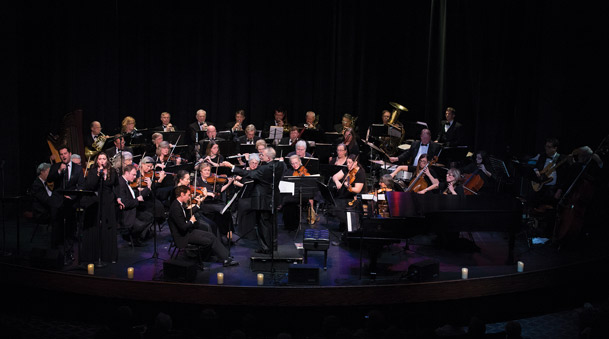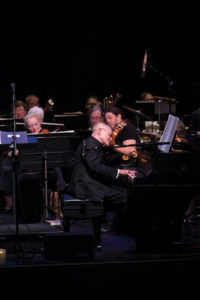by Rochelle Skolnick, Director, Symphonic Services Division and Special Counsel
As a close reader of the “Orchestra News” section of the International Musician might have noticed, orchestra contract settlements over the past year or so have almost uniformly exemplified the “growth not cuts” mantra adopted by the courageous musicians of the Fort Worth Symphony Orchestra during their contentious negotiations and strike. That growth has, in many cases, been incremental rather than dramatic but is nonetheless notable because it is symptomatic of a certain robust health within the symphonic field.
That health was confirmed by a longitudinal study (Orchestra Facts: 2006-2014) released by the League of American Orchestras in November 2016. Although that report received some attention at the time of its release, the press coverage largely missed one of its most important points. The study shows that, although the balance of funding sources for our orchestras has shifted somewhat over time, each of the funding streams upon which orchestras traditionally rely kept pace with or substantially outpaced inflation during the period measured by the study—with the exception of earned income, which trailed inflation by only 1%.
In the case of contributed income from trustees and foundations, which outpaced inflation by 45% and 13% respectively, the differential was dramatic. Yet, despite the industry-wide vigor in funding streams, expenses—the side of the ledger on which we find musician wages and benefits—actually trailed inflation for the same period, by 2.8%.
I believe that the relatively progressive contracts we have begun to see in the period since the League study concluded in 2014 represent a restoration to musicians of some of what was lost in the deeply concessionary bargaining that occurred post-2008. It’s about time.
But that restoration is not happening simply because managers and boards find it in the goodness of their hearts to take care of the musicians whose creativity and dedication draws patrons to concert halls and inspires donors to write checks. It certainly was not employer beneficence that brought the Fort Worth Symphony musicians back to the stage with a progressive contract after 13 weeks on the picket line. Rather, in every case, it has been the musicians’ solidarity and resolve that has won them their recent gains.
That was so for the musicians of the Fort Worth Symphony and it has been so for the musicians of other orchestras making significant gains, including the Buffalo Philharmonic and the Austin, Detroit, Grand Rapids, Indianapolis, Jacksonville, Kansas City, Nashville, National, Pacific, St. Louis, and San Diego orchestras, among others.
It will take similar solidarity and resolve to beat back another peril to American orchestras: threatened cuts to governmental arts funding, including the outright elimination of the National Endowment for the Arts and the National Endowment for the Humanities, contained in the presidential budget proposal released March 16. The $148 million annual budget of the NEA represents just .012% of all federal discretionary spending, yet it profoundly touches the lives of American orchestra musicians and all those they serve.
NEA Funding
That effect is far from speculative or remote. Besides having reached progressive contract settlements in the past year, what do the Buffalo Philharmonic and the Austin, Detroit, Fort Worth, Grand Rapids, Indianapolis, Jacksonville, Kansas City, Nashville, National, Pacific, St. Louis and San Diego symphonies have in common? They all receive NEA grant funding.
In fiscal years 2016 and/or 2017, each one of those orchestras received an NEA grant to support one of a wide range of projects, both strikingly beautiful and culturally relevant. Grants went to support “Imagine Your Parks” events connecting several orchestras (including Jacksonville and St. Louis) with National Parks sites; a community engagement program focused on Buffalo’s international community in partnership with Buffalo Public Schools; premieres of new orchestral works written about and to loved ones (Kansas City); the Pacific Symphony’s American Composers Festival, featuring works by living Southern California-based composers; and the National Symphony Orchestra’s Sound Health initiative, which presents live classical music performances at DC-area medical facilities to enrich the lives of patients, family members, medical staff, and visitors.
These are just a few of the NEA-supported programs that expand minds and build connections among diverse groups of people. While abolition of the NEA would have a negligible effect on the federal budget, it would have a devastating effect on curiosity, intelligence, and empathy.
The March 16 budget proposal is only that—a proposal. It will be up to Congress to write the budget. As that process unfolds, I hope you will ensure your voice is heard in support of continued funding for the NEA and the myriad symphonic projects it enables. Tell members of Congress to Save the NEA at: www.afm.org/2017/02/nea/.
FIM IOC
At a moment when the voices of xenophobia and bigotry are raised louder in our political discourse than I ever thought possible in my lifetime, the International Orchestra Conference (IOC) taking place in Montreal, May 11-14, offers a meaningful opportunity for American and Canadian musicians to share the experiences of our sisters and brothers in symphony orchestras around the globe. The IOC is a project of the International Federation of Musicians (FIM), the international organization for musicians’ unions and representative organizations with approximately 70 institutional members in 60 countries throughout the world.
The AFM will have a substantial presence at the IOC with AFM elected officers (AFM President Ray Hair, Secretary-Treasurer Jay Blumenthal, International Executive Board member and Local 802 President Tino Gagliardi, and Local 406 President Luc Fortin and Secretary Eric Lefebvre); symphonic player conference leaders (ICSOM Chair Meredith Snow, OCSM/OMOSC President Robert Fraser, and ROPA Board Member Naomi Bensdorf-Frisch); and myself serving as moderators and panelists.
Topics covered will include the public value of orchestras, recorded broadcasts and musicians’ rights; orchestras integrating digital tools; practical aspects of outreach and education; unions’ roles in preserving orchestral institutions; the role of musicians serving on orchestra boards; and bullying and harassment. Other US and Canadian panelists will be Robert Massey, executive director of the Jacksonville Symphony, which concluded very progressive contract negotiations this season; Barbara Haws, New York Philharmonic archivist/historian; and Katherine Carleton, executive director of Orchestras Canada. Discussions promise to be lively and to promote understanding among orchestra musicians across international borders. I hope to see many of you joining us in Montreal.




